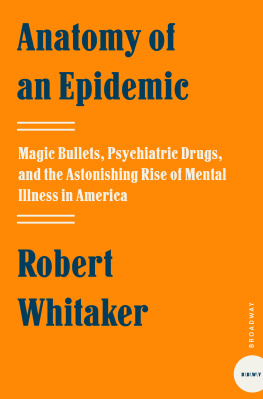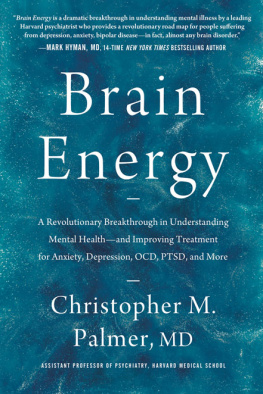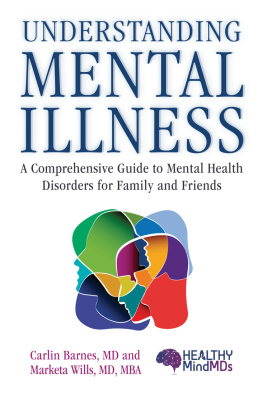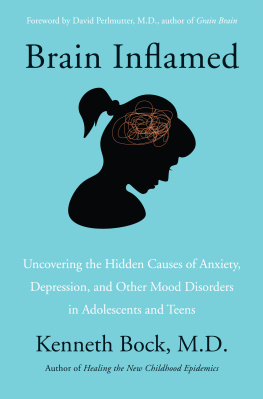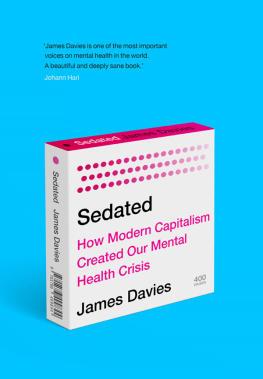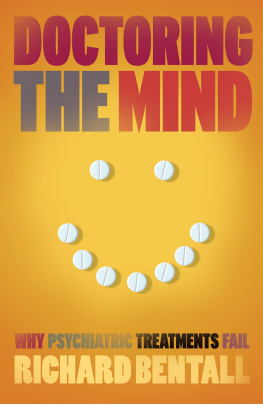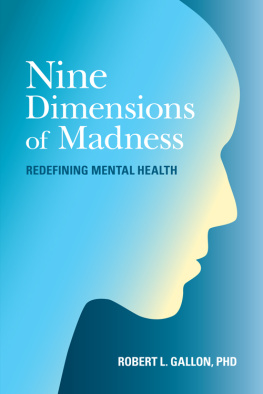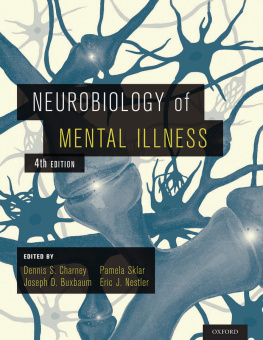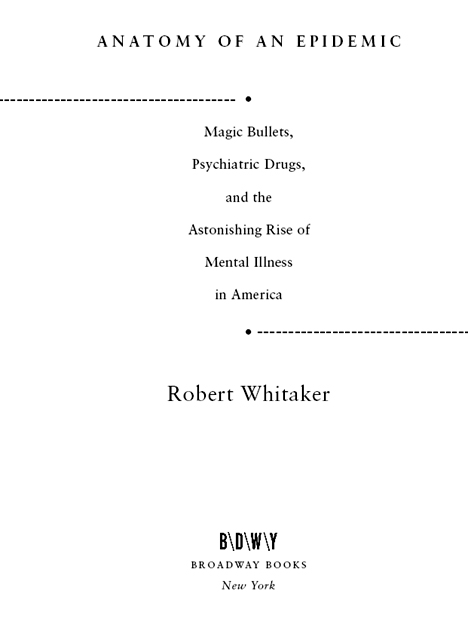Praise for
Anatomy of an Epidemic
What with the conclusions Whitaker draws from his assembled literature and the accusations he levels at those who consciously deceive consumers eager for magical cures, his book will either blow the lid off a multibillion-dollar industry or cause him to be labeled a crackpot and, perhaps, medicated into obscurity. At the very least, it should prod those who take the drugs to question those who prescribe them.
Booklist (starred review)
[Whitakers] arguments are worryingly sane and consistently based on evidence a provocative yet reasonable thesis, one whose astonishing intellectual punch is delivered with the gripping vitality of a novel. Whitaker manages to be damning while remaining stubbornly optimistic in this enthralling and frighteningly persuasive book.
New Scientist
Strips away psychiatrys carefully constructed and brightly painted architecture, then turns a halogen lamp on the pile of dust that remains. Take everything you know about psychiatry. Turn it upside down. Youll have a pretty good idea of what Whitaker discovered. challenge intrigues you, put this book on your reading list.
Examiner.com (Portland)
This is the most alarming book Ive read in years. The approach is neither polemical nor ideologically slanted. Relying on medical evidence and historical documentation, Whitaker builds his case like a prosecuting attorney.
Carl Elliott, MD, PhD; professor, Center for Bioethics, University of Minnesota; and author of Better Than Well
Every so often a book comes along that exposes a vast deceit. Robert Whitaker has written that sort of book. Scrupulously reported and written in compelling but unemotional style, this book shreds the myth woven around todays psychiatric drugs.
Nils Bruzelius, former science editor for the Boston Globe and the Washington Post
Also by Robert Whitaker
Mad in America
The Mapmakers Wife
On the Laps of Gods
To Lindsay
May you sing Seasons of Love again
and be filled with joy
CONTENTS
Part One:
2.
Part Two:
5.
Part Three:
12.
Part Four:
15.
Part Five:
FOREWORD
Anatomy of an Epidemic was first published in 2010, and it is fair to say that it quickly became known as a controversial book. At its core, this book investigates the long-term effects of psychiatric drugs, and it ultimately presents a history of science that challenges psychiatry to rethink our current drug-based paradigm of care.
It is now four years later, and the publication of this updated edition provides two opportunities. The first is to recount the response to Anatomy, which is a revealing story of its own. The second is to provide an update of relevant studies published since 2010. The new studies add to the body of evidence presented in Anatomy in a powerful way. Indeed, I think that the new studies can be seen as corroborating the conclusions drawn in Anatomy.
In the foreword to the first edition, I told of how I came to write this book. More than ever, I think it is important for readers to know this story. When a book challenges conventional wisdom, those who feel stung by the book may respond by attacking the person who wrote it. The author is biased. The author has an agenda. And so forth. The reviewer switches the focus from the book to the author, and by doing so, seeks to discredit the book.
I came to write about this subject in a very roundabout manner. In 1994, after having worked a number of years as a newspaper reporter, I left daily journalism to cofound a publishing company, CenterWatch, that reported on the business aspects of the clinical testing of drugs. Our readers came from pharmaceutical companies, medical schools, private medical practices, and Wall Street, and for the most part, we wrote about this enterprise in an industry-friendly way. We viewed clinical trials as part of a process that brought improved medical treatments to market, and we reported on the financial aspects of that growing industry. Then, in early 1998, I stumbled upon a story that told of the abuse of psychiatric patients in research settings. Even while I co-owned CenterWatch, I occasionally wrote freelance articles for magazines and newspapers, and that fall I cowrote a series on this problem for the Boston Globe.
There were several types of abuses that Dolores Kong and I focused on. We looked at studies funded by the National Institute of Mental Health (NIMH) that involved giving schizophrenia patients a drug designed to exacerbate their symptoms (the studies were probing the biology of psychosis). We investigated the deaths that had occurred during the testing of the new atypical antipsychotics. Finally, we reported on studies that involved withdrawing schizophrenia patients from their antipsychotic medications, which we figured was an unethical thing to do. In fact, we thought it was outrageous.
Our reasoning was easy to understand. These drugs were said to be like insulin for diabetes. I had known that to be true for some time, ever since I had covered the medical beat at the Albany Times Union. Clearly, then, it was abusive for psychiatric researchers to have run drug-withdrawal studies in which they carefully tallied up the percentage of schizophrenia patients who became sick again and had to be rehospitalized. Would anyone ever conduct a study that involved withdrawing insulin from diabetics to see how fast they became sick again?
Thats how we framed the withdrawal studies in our series, and that would have been the end of my writing on psychiatry except for the fact that I was left with an unresolved question, one that nagged at me. While reporting that series, I had come upon two research findings that just didnt make sense. The first was by Harvard Medical School investigators, who in 1994 announced that outcomes for schizophrenia patients in the United States had worsened during the past two decades and were now no better than they had been a century earlier. The second was by the World Health Organization, which had twice found that schizophrenia outcomes were much better in poor countries, like India and Nigeria, than in the United States and other rich countries. I interviewed various experts about the WHO findings, and they suggested that the poor outcomes in the United States were due to social policies and cultural values. In the poor countries, families were more supportive of those with schizophrenia, they said. Although this seemed plausible, it wasnt an altogether satisfactory explanation, and after the series ran in the Boston Globe, I went back and read all of the scientific articles related to the WHO study on schizophrenia outcomes. It was then that I learned of this startling fact: In the poor countries, only 16 percent of patients were regularly maintained on antipsychotic medications.
I can still remember my feelings of confusion upon seeing that statistic. I had just cowritten a series that had focused, in one of its parts, on how unethical it was to withdraw schizophrenia patients from their medications, and yet here was a study by the World Health Organization that seemingly had found an association between good outcomes and not staying continuously on the drugs. I wrote my first book,

